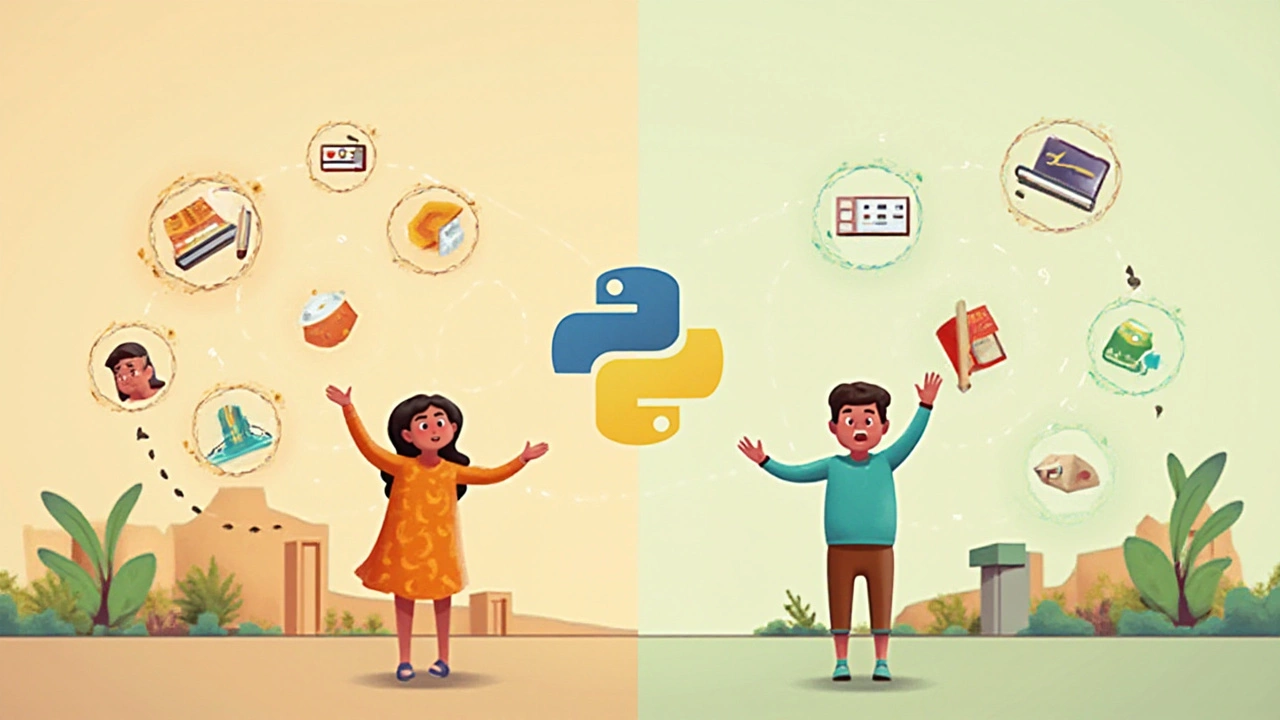Is Python More Beginner-Friendly Than JavaScript?
In the ever-evolving world of programming, Python and JavaScript continue to dominate the landscape as leading languages used by developers across the globe. Both languages offer distinct advantages but cater to different needs, which often leaves newcomers pondering which is easier to learn.
Python is frequently praised for its simple and clean syntax, making it an attractive choice for beginners diving into the coding universe. On the other hand, JavaScript is indispensable in the realm of web development, powering interactive and dynamic websites. As we delve into the intricacies of these languages, it's vital to understand how their differences might influence a novice programmer's learning journey.
- Understanding Python and JavaScript
- Syntax and Readability
- Use Cases and Applications
- Community and Learning Resources
- Choosing the Right Language for You
Understanding Python and JavaScript
Diving into the world of coding can be both exhilarating and daunting, especially when faced with the decision of choosing a first programming language. Among the myriad of options, Python and JavaScript consistently emerge as popular choices for novices and experts alike. While Python is often celebrated for its simplicity and elegance, offering a gateway into the programming world with ease, JavaScript reigns supreme in the web development realm, providing the bedrock for dynamic and engaging online experiences.
Python's journey begins in the early 1990s with its creator, Guido van Rossum, who aimed to develop a language that emphasizes readability and simplicity. Driven by clarity, Python’s syntax mimics everyday speech, making it remarkably intuitive. This characteristic strikes a chord with newcomers who might otherwise be discouraged by the cryptic nature of other languages. The whitespace principle—where code blocks are defined by their level of indentation—enforces clean and organized code, reducing learning hurdles. Python’s adaptability also plays a key role in its appeal, extending its utility to web development, data science, artificial intelligence, and automation effortlessly. Many consider its thriving ecosystem of libraries and frameworks, like Django and Flask, as pivotal tools that expand its capabilities, nurturing both budding programmers and seasoned developers.
In contrast, JavaScript's roots delve deep into the rich soil of web development. Introduced in the mid-90s by Netscape, JavaScript quickly transformed into an essential element of modern web architecture. The language excels in bringing static web pages to life with interactive features, shaping user experiences on a global scale. As a lightweight and versatile scripting language, JavaScript seamlessly integrates with HTML and CSS, forming the triumvirate that builds the fabric of the internet. Its evolution over the years, particularly with the advent of frameworks like React, Angular, and Vue.js, has reinforced JavaScript’s prominence, empowering developers to create immersive and responsive applications. The language’s non-blocking, asynchronous nature enables efficient handling of operations, a crucial feature in the era of real-time web applications.
As one delves deeper into the world of coding, it's interesting to note the vast and vibrant communities that thrive around these languages. Python’s user base is characterized by its welcoming and supportive ethos, exemplified by resources such as forums and local meetups that nurture aspiring developers at every step. Similarly, JavaScript benefits from an ever-growing ecosystem, bolstered by its vast array of tools, plugins, and continuously evolving standards that propel the language forward. Underpinning these communities is an abundance of educational content, accessible through a variety of platforms, empowering learners with the knowledge they need to succeed.
"Any programmer can write code that a computer can understand. Good programmers write code that humans can understand," notes Martin Fowler, capturing the essence of what Python strives to achieve.
In examining both languages, understanding their core philosophies and intended use cases can significantly impact a new programmer’s trajectory. Python’s emphasis on simplicity and readability aligns with a broad spectrum of applications, making it a versatile choice for those looking to explore multiple avenues. Conversely, JavaScript’s pivotal role in web development and ability to create dynamic user interactions cannot be understated. The choice between these two often depends on the individual's goals, whether they aim to harness Python’s versatility or delve into the vibrant world of JavaScript-driven web development. As each language continues to expand its horizons, they collectively enrich the ever-evolving landscape of programming.
Syntax and Readability
When diving into the world of coding, the syntax of a programming language can often make or break a beginner's experience. Python is often heralded as one of the easiest languages to learn, primarily because of its clear and concise syntax. Designed with readability in mind, Python's syntax uses plain English and emphasizes the importance of whitespace to define code blocks, making it less intimidating to new programmers. This characteristic alone often appeals to those who are new to coding, reducing the clutter often associated with other languages and allowing learners to focus more on solving problems rather than deciphering complex code structure.
JavaScript, on the other hand, is known for its flexibility, a feature that can both amuse and confuse new learners. Its syntax, while not as straightforward as Python’s, follows conventions that become second nature with practice. JavaScript relies on the use of curly braces to define blocks and semicolons to end statements, which might initially seem cumbersome but are vital for understanding and controlling program flow. As developers become more comfortable with these conventions, they find a language that offers dynamic capabilities, especially in web development, where real-time updates and interactive user experiences are key.
"The simplicity of Python is what attracted me initially. It's like writing in plain English... and the support from the community is just incredible." — Guido van Rossum, Creator of Python
Interestingly, both languages have garnered massive community support, providing a wealth of resources for newcomers. Python's syntax is often praised in the academic world for its utility in teaching computer science fundamentals, while JavaScript is indispensable in any discussion about front-end development. As you navigate your learning journey, it is crucial to consider what kind of projects you wish to undertake. Python's readability and simplicity make it a top choice for data analysis, machine learning, and backend development, while JavaScript reigns supreme for those interested in building interactive user interfaces and enriching web experiences.
The prevalence of these languages in various sectors also means that documentation and tutorials are abundant. From well-structured textbooks to active forums and online courses, both languages offer diverse pathways for mastering their syntax and nuances. Many beginners appreciate Python's indentation-based block structuring since it reduces syntax errors and enforces clean coding practices, promoting not just ease of writing but also ease of reading code. In the realm of JavaScript, its async capabilities and event-driven architecture open doors to exciting projects that can be shared instantly across the web, providing new coders with a sense of accomplishment as they bring their ideas to life.

Use Cases and Applications
When we dive into the practical world of programming, both Python and JavaScript shine in their unique ways, each carving out a niche in the technological sphere. Python, often referred to as the 'programming language of the future,' is highly versatile and finds applications in a myriad of fields. It is particularly predominant in data science, artificial intelligence, and machine learning. Data analysts and researchers love Python for its libraries like pandas, NumPy, and TensorFlow, which facilitate data manipulation, visualization, and predictive modeling.
Beyond the realm of data, Python is also extensively used in automation, allowing day-to-day tasks to be done more efficiently. Its ability to interface easily with operating systems makes it an excellent choice for writing scripts to manage system tasks or automate mundane data entry work. In web development, Python doesn't lag; web frameworks like Django and Flask have made it a viable option for server-side coding, enabling the development of robust web apps with relative ease.
On the flip side, JavaScript reigns supreme in the domain of web technology. It is a must-have skill for any web developer, providing the backbone for dynamic and interactive web pages. The language works in tandem with HTML and CSS to breathe life into static pages, making them engaging and user-friendly. Whether it’s creating responsive buttons, animated menus, or real-time content updates, JavaScript is indispensable. It has also grown beyond client-side development with environments like Node.js, enabling developers to write server-side scripts that handle multiple connections simultaneously.
As a matter of fact, JavaScript has expanded its reach to mobile app development through frameworks like React Native and Ionic, showing that it is not limited to just web browsers. Applications such as Slack, a widely used business communication tool, were built using JavaScript frameworks, evidencing its capability to run complex and scalable applications. A quote from Brendan Eich, the creator of JavaScript, summarizes its versatility beautifully:
"Always bet on JavaScript."
JavaScript is also heavily utilized in game development, particularly for browser games where developers can create and deploy interactive games right in the user's browser without the need for additional plugins. Libraries like Three.js bring powerful solutions for adding 3D visuals and animations to games, enticing developers who are venturing into virtual reality experiences. With the advent of modern tools, JavaScript continually proves its versatility in becoming a go-to language for many innovative technologies.
To provide a clearer picture of where these languages intersect within industry standards, here is a simplified comparison table considering Python and JavaScript's strong suits:
| Python Use Cases | JavaScript Use Cases |
|---|---|
| Data Analysis & Visualization | Web Interactivity & Animation |
| Machine Learning & AI | Mobile Application Development |
| Task & Process Automation | Real-Time Web Applications |
Choosing between Python and JavaScript boils down to what you aim to achieve in the technological realm. If your interests align more with analyzing big data sets or developing AI algorithms, Python offers a streamlined path with abundant resources. However, if creating visually dynamic websites or venturing into multi-platform app development calls to you, JavaScript would be the language to hone your skills in. Both languages are powerful in their right, continually shaping the digital landscape.
Community and Learning Resources
Diving into programming can be quite daunting at first, but both Python and JavaScript have extensive communities and learning resources that can act as guiding hands on your journey. Over the years, Python has amassed a vibrant community, thanks largely to its application in data science, machine learning, and automation tasks. With platforms such as Stack Overflow and GitHub, aspiring Python developers will find plenty of forums and repositories rich with existing code and active discussions.
Python's appeal also means there's no shortage of free and premium resources available online. Websites like Coursera and Khan Academy offer structured courses that cater to distinct learning styles, with topics ranging from basic scripting to advanced data analysis. Additionally, the Python Software Foundation actively supports education and programming literacy, making Python an approachable option for many.
Expansive Support for JavaScript
JavaScript, on the other hand, boasts an equally impressive community, pivotal for any developer keen on web development. As the primary scripting language of the internet, there's a wealth of libraries and frameworks—like React, Angular, and Vue—that enhance JavaScript's utility. Many web developers have found Javascript indispensable, with active user forums and mailing lists where experienced coders share insights and troubleshoot common issues.
Interactive platforms such as Codecademy and freeCodeCamp offer robust lessons, ranging from fundamental basics to more complex projects, making the learning curve less steep. Moreover, the Mozilla Developer Network (MDN) provides comprehensive documentation that is invaluable for both beginners and seasoned programmers alike. It's their way of contributing to the ecosystem and ensuring JavaScript's wide accessibility.
"The web is the greatest canvas for learning and interaction; JavaScript is the brush." —Mozilla Contributor
Moreover, let's not forget the impact of coding bootcamps which have surged in popularity. These intensive programs often emphasize practical skills and provide direct industry connections, making them a fast-track option for many ambitious learners.
Community Engagement and Growth
Community engagement isn't just about consuming content but also contributing. As you grow more confident, participating in hackathons and open-source projects can accelerate learning and expand networking opportunities. This engagement is often the differentiator between a budding coder and a proficient programmer, as real-world applications of lessons learned enhance understanding significantly.
Whether you choose Python or JavaScript, remember that the journey is continuous. The thriving communities surrounding these programming languages offer a safety net of information and support, underscoring the importance of choice less about difficulty and more about where you see yourself applying these skills in the future.

Choosing the Right Language for You
Selecting between Python and JavaScript can seem like a daunting decision, especially for new programmers eager to dive into the vast sea of coding. Each language brings its own flavors and utilities, appealing to various aspects of the technological world. When considering which path to take, it's important to reflect on what you aspire to achieve in the programming domain. Are you aiming towards data analysis, machine learning, and automation tasks? Or does your interest incline more towards crafting interactive web pages and dynamic websites? Your goals will guide this pivotal choice.
When we talk about Python, we talk about simplicity and elegance. Python’s syntax often resembles the structure of the English language, which makes it relatively easy for beginners to grasp. Its readability allows you to learn coding concepts without getting lost in a swamp of complicated syntax rules, making the learning curve smoother for many developers. The nature of Python is such that you can quickly write functional code, which makes it a fantastic language for prototyping and iterative development. It is widely used in fields like data science, artificial intelligence, and automation—all burgeoning areas with significant career opportunities.
In contrast, JavaScript offers a different kind of magic. Renowned as the language of the web, its versatility stretches from front-end development to server-side scripting when combined with technologies like Node.js. JavaScript allows developers to create websites with dynamic and interactive elements—functions that users have come to expect and adore. Mastering JavaScript opens doors to becoming a full-stack developer, a skill set highly prized in the tech industry today. Despite its quirks and complex ecosystem, JavaScript has an abundance of frameworks—like React, Angular, and Vue—that simplify the building of sophisticated applications.
"Python's ability to handle large datasets easily makes it ideal for analyzing and visualizing data," said an expert from the renowned development community. "On the other hand, JavaScript's real-time update capability is crucial for web-centric applications."
A critical aspect to consider in your decision also involves assessing the strength and involvement of each language's community. A robust community can offer essential support through documentation, tutorials, forums, and open-source projects, enabling you to learn faster and troubleshoot problems more efficiently. Both Python and JavaScript boast substantial and active communities, each offering unique resources. Websites like Stack Overflow abound with Python and JavaScript queries and solutions, making community support readily accessible for learners.
| Language | Key Domains | Ease of Learning |
|---|---|---|
| Python | Data Science, Machine Learning, Automation | High |
| JavaScript | Web Development, Full-Stack Development | Moderate |
Ultimately, the choice between Python and JavaScript boils down to individual preferences and career aspirations. Consider what excites you about technology and programming, and how the capabilities of each language align with your goals. With determination and curiosity guiding your path, you'll find success with either language, as both command respect and offer opportunities in today's interconnected world. Embrace the learning journey, and remember that the skills you develop will transfer across languages, fostering a deeper understanding of programming as a creative craft.





